Dinas Mawddy is a town in the community of Mawddwy, in the ancient county of Merionethshire, which lies within the Snowdonia National Park, just to the east of the main A470. The village marks the junction of the unclassified road to Llanuwchllyn which climbs up through the mountains to cross Bwlch y Groes at its highest point, the second highest road pass in Wales. This minor road also provides the closest access to the mountain Aran Fawddwy and is the nearest settlement to Craig Cywarch. The men of the area who fell during both World Wars are commemorated on a war memorial, which sits alongside the main A470 road, in the hamlet of Minllyn.
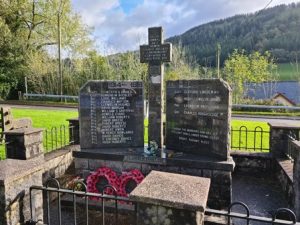
The Great War, 1914-1918
David Breese, Private, 55318, Royal Welsh Fusiliers. David was the son of John and Janet Breese, of Brandy, Dinas Mawddwy. He worked as a journalist at Oswestry prior to the war. David enlisted at Welshpool into the Royal Welsh Fusiliers, and after completing his training was posted to France, joining the 14th Battalion, Royal Welsh Fusiliers, which was attached to 113 Brigade, 38th (Welsh) Division. The Division had moved to France during the first week of December 1915 and moved to the Nursery Sector near Fleurbaix for trench initiation alongside the Guards Division. In June 1916 the Division marched south to the Somme, and on 7 July launched its first assault on Mametz Wood. A second assault was launched on 10 July, and after two days of fierce fighting, the Division was withdrawn and moved just north to Hébuterne. After a month here, the Division was moved further north again, before taking up the Canal Bank sector of the line to the north of the city of Ypres, and would remain here for almost a year, the various battalions taking turns to hold the front line. On 13 February 1917 the 14th RWF moved back into the front line to begin a short tour and on the night of 16/17 February the battalion sent a strong raiding party out to gain intelligence. The battalion suffered a number of casualties and was relieved on the following day, 18 February. David is recorded as having been killed in action on 18 February 1917, but was most likely killed during the raid on the previous morning. The 30-year-old has no known grave and is commemorated on the Ypres (Menin Gate) Memorial, Belgium. A brother, Robert, had died whilst serving with the Royal Engineers just seven months previously.
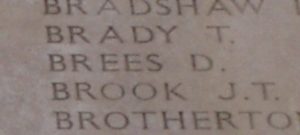
Robert Breese, Private, 167766, Royal Engineers. Robert was the son of John and Janet Breese, of Brandy, Dinas Mawddwy. He worked as a joiner prior to enlisting at Dolgellau into the Royal Engineers on 21 February 1916 and, probably due to his trade, was posted to the 2nd Tunnelling Company, RE and posted to Clipstone Camp for training. On 22 May 1916, just three months after enlisting, Robert began to feel ill, and went to the camp hospital for treatment. His temperature started to climb and he was given treatment of mist of soda salicyl, and appeared to be recovering, before dying of influenza at Clipston Camp Military Hospital on 31 May 1916, aged 34. His remains were brought home and he was buried by Reverend J. Davies at St. Tydecho Churchyard, Mallwyd. His mother Janet died soon afterwards.
Edmund Maurice Buckley, Second Lieutenant, Royal Welsh Fusiliers. Edmund was born on 1 December 1886, the only son of Sir Edmund Buckley, Second Baronet Mawddy, and Lady Harriet Olivia Louise Buckley (nee Lloyd), of Aberhirnant Hall, Bala; Plas Dinas, Dinas Mawddwy; Milford Hall, Newtown; Grotton Hall, Saddleworth; and of Maesllan, Barmouth. He was educated at Cheltenham College before entering Manchester University in 1904 to study engineering. Upon graduating, he begun working for Humber Works Limited at Beeston, and Coventry and was placed in charge of the Motor Cycle Repair Department. He played rugby for Coventry and was the Captain of the second XV. Edmund enlisted into the Public Schools Battalion, London Regiment as a Private at the outbreak of war, and on 21 September 1914 was commissioned into the 7th Battalion, Royal Welsh Fusiliers. The battalion was a Territorial unit, which mobilised for war at Newtown in August 1914, as part of North Wales Brigade, Welsh Division and moved to Conway until the end of the month, before moving to Northampton. In December the Division moved to Cambridge and then in May 1915 to Bedford, where the Division was numbered and the formation became 158 Brigade, 53rd (Welsh) Division. On 19 July 1915 the entire Division sailed from Devonport for Imbros and on 9 August 1915 landed at Suvla Bay. The infantry moved off the beaches into the bush, but due to a lack of maps and no knowledge of the terrain, many of the units became disorientated, and the situation became chaotic. On the morning of 10 August the Division took part in an advance on Scimitar Hill under heavy fire and suffered terrible casualties, before being forced to withdraw. Edmund was wounded during the fighting, and died of his wounds on 12 August 1915, aged 29. He is buried in Lancashire Landing Cemetery, Gallipoli. Upon the death of his father in 1919, the title of Baronet Mawddy also died. Edmund is also commemorated on at least two other war memorials, at Newtown and at Barmouth.
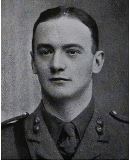
David Davies, Private, 290920, Royal Welsh Fusiliers. David was the son of David and Sarah Davies, of Pantyronen, Aberangell. He worked as a farm servant at Aberhiriaeth, Cemmaes prior to enlisting into the 7th Battalion, Royal Welsh Fusiliers at Newtown on 29 December 1914. David was posted to the 3/7th Battalion, RWF at Park Hall Camp, Oswestry for training and on 26 February 1916 embarked at Devonport for Egypt, to join the 1/7th Battalion, Royal Welsh Fusiliers. The Battalion was on the Suez Canal defences as part of the 53rd (Welsh) Division, having been evacuated from Gallipoli in December 1915. The Division was attached to the EEF, and spent most of 1916 guarding the Suez Canal before helping drive the Turks out of the Sinai, prior to a planned offensive by the EEF to enter Palestine and drive the Turks from the coastal city of Gaza. On 26 March 1917 the EEF launched its attack, known as the First Battle of Gaza, but a heavy fog shrouded the battlefield, and the attacking divisions lost touch with each other, causing a break in communications. In the chaos, the 53rd Division withdrew from the ground it had won at heavy cost, and the battle ended in failure. David had been killed during the days fighting. The 23-year-old has no known grave and is commemorated on the Jerusalem Memorial, Israel.
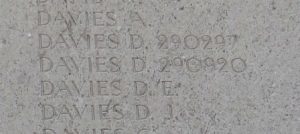
Edward Chesney Davies, Private, 61052, Royal Welsh Fusiliers. Edward was the son of Richard and Margaret Davies, of Mawddy Cottage, Dinas Mawddy. He enlisted at Dolgellau into the army and after completing his training was posted out to France in the spring of 1917, joining the 17th Battalion, Royal Welsh Fusiliers, which was attached to 115 Brigade, 38th (Welsh) Division. The Division was by then in the Canal Bank sector, to the north of the city of Ypres, preparing to launch its offensive on the Pilckem Ridge, as part of the opening of the Third Battle of Ypres. The Divisions assault was a success, and it remained at Ypres while its 114 Brigade took part in the ensuing Battle of Langemark. On 9 September the Division began to move away from the area to new positions near Armentieres, at Sailly-sur-la-Lys. It remained here until being moved back to the Somme at the end of March 1918 to relieve the battered 2nd and 47th Divisions facing the heights of Bouzincourt Ridge. 113 Brigade took part in an operation to drive the Germans off the ridge soon afterwards, affording the Division the high ground overlooking the Ancre Valley towards Thiepval Ridge. On 21 August the Division launched its offensive across the Ancre valley and stormed Thiepval Ridge before taking part in the general advance towards the Hindenburg Line. The line was broken on 29 September and the Allies began driving the Germans back towards the frontier of Germany. By the first week of October the 38th Division had reached Aubencheul-aux-Bois and was preparing to attack Villers-Outréaux. Edward was killed during this attack on 8 October 1918, aged 20. He has no known grave and is commemorated on the Vis-en-Artois Memorial, Haucourt, France.
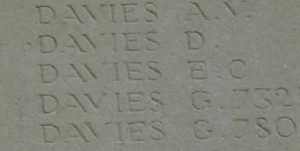
Iorwerth Gwilym Davies, Captain, Royal Air Force. Iorwerth was the son of Edward Hurst Davies and Margaret Davies (nee Evans), of Brynderwen, Aberangell. He enlisted into the Lincolnshire Regiment, and landed in France on 1 March 1915, taking part in the Battle of Neuve Chapelle before being commissioned into the 9th Battalion, South Wales Borderers on 10 March 1915. He went back to England and joined the battalion at Pembroke Dock for training. He then volunteered for the Royal Flying Corps and after training as a pilot was posted to Palestine, where he remained until being granted leave early in 1918 and returned to England again, after being mentioned in despatches. He became an instructor at the 54th Training Depot Station at Fairlop, near Ilford, Essex. On 2 September 1918, Iorwerth was performing aerobatics in Avro 504k D2110 when the aircraft stalled and dived into the ground, mortally injuring him. He died that same day, aged 25. His body was conveyed back to Aberangell, before being conveyed on a gun carriage to Cemmaes Calvinistic Methodist Chapelyard, where he was buried with full military honours on Saturday 7 September, at 13.30.
Hywel Evans, Private, 242715, South Lancashire Regiment. Hywel was born at Llanfachreth in 1887, the illegitimate son of Elizabeth Evans, of Penrhos Isaf. He was raised by his grandparents, Morris and Jane Evans, before becoming a carter at Felin Newydd, Rhydymain. Hywel married Jane Ellen Williams on 16 December 1913 and the couple set up home at Tyddynynoch, Brithdir. He enlisted into the South Lancashire Regiment at Wrexham on 25 October 1916, and after completing his training was posted to France on 17 February 1917, joining the 2/5th Battalion, South Lancashire Regiment. He served on the Western Front until taking ill, and returned to Britain for treatment on 23 November 1917. It was almost five months until Hywel was fit enough to re-join his unit, and he arrived back in France on 8 April 1918, before being posted to the 2/4th Battalion, South Lancashire Regiment. The battalion was attached to 172 Brigade, 57th (West Lancs) Division in the Gommecourt area. It remained here until moving to the Arras sector to take part in the launch of the great Allied offensive on 21 August 1918, and began driving towards the Hindenburg Line. The 2/4th South Lancs were in billets at Mercatel on the opening day of the offensive and on 27 August moved forwards to take up the offensive, with orders to assault the village of Hendecourt, and at 12.30 on 28 August 1918 launched its attack behind a creeping artillery barrage. Within four hours the battalion had successfully taken the village, but had suffered some losses. Hywel was among twenty men killed during the days fighting. The 31-year-old is buried in Dury Crucifix Cemetery, France. He is also commemorated on the Dolgellau memorial.
William Spencer Griffiths, Private, 25698, Norfolk Regiment. William was the son of Evan and Fanny Griffiths, of the Red Lion, Dinas Mawddy. He worked as a shop assistant at King’s Lynn prior to the war, and enlisted in the town into the Norfolk Regiment. Upon completing his training, he was posted to the 9th Battalion, Norfolk Regiment, which was in France attached to 71 Brigade, 6th Division. He arrived in France to take part in the Divisions efforts during the Somme offensive, where it took part in the Battle of Flers-Courcelette, the Battle of Morval and the Battle of Le Transloy. The following year saw the Division at Arras, where it fought at the Battle of Hill 70, and then during the Battle of Cambrai later in the year. On 21 March 1918 the battalion was in the front line at Lagnicourt, when at 05.00 it came under heavy artillery and gas bombardment, which marked the opening of the German Spring Offensive. Following up this bombardment came well-trained German stormtroopers, and heavy fighting ensued. The Germans swallowed up the battered British front line and began fighting over the reserve positions. William was killed in action at some time during the days fighting. The 29-year-old has no known grave and is commemorated on the Arras Memorial, France.
Llewelyn Hughes, Private, 12671, Devonshire Regiment. Llewelyn was the son of Edward and Jane Hughes, of 5 Brook Terrace Dinas Mawddwy. He was working in the South Wales valleys prior to the war and enlisted at Ynyshir into the 9th Battalion, Devonshire Regiment. The battalion formed at Exeter on 15 September 1914 and landed at Le Havre on 28 July 1915, joining 20 Brigade, 7th Division at Calonne sur-la-Lys. Llewelyn would have seen his first action during the opening assault of the Battle of Loos on 25 September, where the 7th Division seized the Quarries. Llewelyn returned home on leave in the spring of 1916, and married Jane Evans, of 2, Brook Terrace. He re-joined his battalion on the Somme after his leave. During the coming months the Division saw heavy fighting on the Somme, becoming the first troops into High Wood and continued to fight on the Somme until the closure of the battle, before spending the winter on the Ancre. The Division then moved to the Arras sector, and took part in ferocious fighting during the Battle of Bullecourt, alongside the Australians, before moving to Ypres later in the summer. The Division then took part in the terrible fight for Polygon Wood, before advancing and taking part in the Battle of Broodseinde, again alongside the Australians. On 26 October 1917 the Division attacked the German positions to the south of the Menin Road, the 9th Devons leading the way, with the 2nd Border Regiment on their flank. The Borders came under heavy fire and failed to advance, to the 9th Devons, who had moved forward, were met with heavy fire from their flank, and suffered terrible casualties. Llewelyn was among those killed during the attack that day. The 34-year-old has no known grave and is commemorated on the Tyne Cot Memorial, Belgium.
Edwin Evan Jones, Lieutenant, Labour Corps. Edwin was the son of John and Ann Jones, of Chelsea, London. His parents were from west Wales, his father from Aberdyfi and his mother from Dinas Mawddy. The family ran a successful business, John Jones (Chelsea) Ltd, at their factory at Carlisle Works, Chelsea, and Edwin had run it himself, being granted the Freedom of the City of London on 18 May 1909. Edwin enlisted into the Royal Army Medical Corps upon the outbreak of war, and served in Egypt from 17 March 1915. Edwin was commissioned into the Egyptian Labour Corps on 29 April 1918, and continued to serve in the Middle East until after the Armistice. Edwin returned to England aboard the same ship as Sir Edmund Allenby, intending to take up the reins of the family business, John Jones, Carlisle Works, Chelsea Ltd. He was on holiday at his parents’ home at Hyfrydle, Aberdyfi, when he suddenly became ill and died on 25 September 1919, aged 40. He was buried in Aberdyfi Cemetery. Edwin does not appear to be commemorated locally.
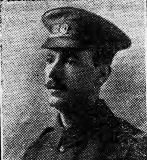
David Morgan, Private, R/15057, King’s Royal Rifle Corps. David was the son of David Morgan and Ann Morgan (nee Davies), of Glanllyn Mawr, Dinas Mawddy. His father died when he was young, and his mother moved to Southampton, so David was raised by his grandparents until old enough to join his mother, who had remarried to George Hallum in 1906. David worked as a carman prior to enlisting at Southampton into the 14th Battalion, King’s Royal Rifle Corps on 16 August 1915 and was posted to Winchester for training. On 23 December 1915 he was posted to France, where he joined the 13th Battalion, King’s Royal Rifle Corps, which was attached to 111 Brigade, 37th Division. On 1 July 1916 the Battle of the Somme opened, and the 14th KRRC, in the line at Berles, could hear the roaring of the guns just to their south. On the following day the 37th Division was relieved and moved into billets at Saulty, before going into reserve at Pas on 3 July. Two days later, the 14th KRRC moved forwards to Albert to join the 34th Division, and by 7 July was at Becourt Wood. On 9 July the 34th Division relieved the 19th Division and whilst entering into the trenches came across countless bodies of British and German troops who had been killed during the heavy fighting beforehand. During the following day, 10 July 1916, the 14th KRRC began work on removing the dead and clearing and repairing their trenches, but came under enemy fire several times during the day. David was killed here during the day. The 20-year-old is buried in Gordon Dump Cemetery, Ovillers-La Boisselle, France.
Robert Owen, Private, 37022, Royal Welsh Fusiliers. David was the son of David and Margaret Owen, of Pandy Newydd, Dinas Mawddy. He enlisted at Denbigh into the 20th Battalion, Royal Welsh Fusiliers on 20 November 1915 and was sent to Conwy for his medical before joining the battalion at Kinmel Park. The battalion was a reserve unit, which trained men ready to send to the front to join the Service Battalions of the Royal Welsh Fusiliers. Robert had almost completed his training at Kinmel Park when he became ill and died of lobar spinal fever in Bangor Military Hospital on 1 April 1916, aged 18. His remains were conveyed home and Robert was laid to rest in the Mallwyn (Dinas Mawddwy) Old Cemetery. His mother was from Llansannan, and Robert is also commemorated on the war memorial there.
David Roberts, Private, 291701, Royal Welsh Fusiliers. David was the son of David Roberts, of Dornant Fawr, Dinas Mawddy. He enlisted at Dolgellau into the 7th Battalion, Royal Welsh Fusiliers and was posted to the 3/7th Battalion, Royal Welsh Fusiliers, which was at Park Hall, Oswestry, for training. He was posted out to Egypt at some time in 1916, joining the 1/7th Battalion, Royal Welsh Fusiliers. The Battalion was on the Suez Canal defences as part of the 53rd (Welsh) Division, having been evacuated from Gallipoli in December 1915. The Division was attached to the EEF, and spent most of 1916 guarding the Suez Canal before helping drive the Turks out of the Sinai, prior to a planned offensive by the EEF to enter Palestine and drive the Turks from the coastal city of Gaza. On 26 March 1917 the EEF launched its attack, known as the First Battle of Gaza, but a heavy fog shrouded the battlefield, and the attacking divisions lost touch with each other, causing a break in communications. In the chaos, the 53rd Division withdrew from the ground it had won at heavy cost, and the battle ended in failure. A second assault was launched against Gaza on 17 April, but fared no better, forcing the EEF to restructure, and its two senior officers were sent home and replaced. David was wounded and taken prisoner during the failed offensive, and was sent to a Turkish camp in Damascus. He died there of his of wounds on 22 June 1917 and is buried in Damascus Commonwealth War Cemetery, Syria.
Hugh Pugh Roberts, Private, 285138, South Wales Borderers. Hugh was the son of John and Jane Roberts, of Bryn Horeb, Aberangell. He worked as a postman prior to enlisting at Newtown into the 7th Battalion, Royal Welsh Fusiliers on 2 December 1914 and was posted to Park Hall camp, Oswestry, joining the 3/7th Battalion. On 13 June 1917 Hugh was posted to No 5 Infantry Base Depot in France, and from there was transferred to the Monmouthshire Regiment. He was then posted to the 2nd Battalion, South Wales Borderers, which was attached to 87 Brigade, 29th Division. Hugh joined up with the battalion at Ypres, where it was preparing to take part in the Third Battle of Ypres, which was launched on 31 July 1917. On 15 August the battalion moved forwards towards the Steenbeek and took up support positions near Saules Farm, in preparation to launch an attack on the following morning. At 04.45 on 16 August 1917 the artillery barrage opened and the men arose from their trenches, storming their objectives, near to the ruined hamlet of Wijdendrift, near Langemarck. Hugh was among four officers and 27 men killed during the days fighting. The 22-year-old is buried in Artillery Wood Cemetery, Belgium.
William Roberts, Private, 290888, Royal Welsh Fusiliers. William was the son of John and Emma Roberts, of Weir Cottage, Dinas Mawddwy. He worked as a farm servant prior to enlisting at Newtown into the 7th Battalion, Royal Welsh Fusiliers on 2 December 1914. The battalion was a Territorial unit, which mobilised for war at Newtown in August 1914, as part of North Wales Brigade, Welsh Division and moved to Conway until the end of the month, before moving to Northampton. In December the Division moved to Cambridge and then in May 1915 to Bedford, where the Division was numbered and the formation became 158 Brigade, 53rd (Welsh) Division. On 19 July 1915 the entire Division sailed from Devonport for Imbros and on 9 August 1915 landed at Suvla Bay. The Division fought at Gallipoli until being evacuated in December 1915 and moved to Egypt, joining the EEF on the Suez Canal Defences and helped clear the Turks from the Sinai. On 26 March 1917 the EEF launched an offensive into Palestine against the coastal city of Gaza, but due to poor communication, partly caused by a thick fog cloaking the battlefield, the attack failed. A second attempt to clear Gaza was launched on 17 April, but again failed, and as a result the EEF was re-organised and its commanding officers relieved and on 1 November 1917 a third attempt was made, across a wider front, which drove the Turks from Beersheba and Gaza, clearing the way to Jerusalem. William had survived all of these major actions, but was killed in action during the advance to Jerusalem, during the assault on Khuweilfeh Hill, on 6 November 1917, aged 21. He is buried in Beersheba War Cemetery, Israel.
William Percy Rowlands, Private, 40749, South Wales Borderers. William was the son of William and Mary Rowlands, of Station House, Llanbrynmair. He enlisted at Wrexham into the army, and was posted to the 2nd Battalion, South Wales Borderers, which was attached to 87 Brigade, 29th Division. The Division moved to the Western Front after service at Gallipoli, on 15 March 1916. It took part in its first major action in France during the 1916 Somme Offensive, and fought at the Battles of Albert and Le Transloy, suffering heavy casualties. In the Spring of 1917, the Division fought at the Battle of the Scarpe, which was part of the Arras Offensive, and then moved further north to Ypres. Here the Division fought at the Battle of Langemarck. William was killed in action at Langemarck on 20 August 1917, during fighting near Saules Farm. He was 19 years old, and is commemorated on the Tyne Cot Memorial, Belgium.
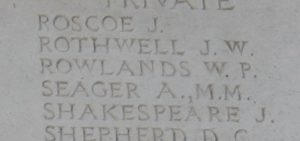
Charles Watson, Sergeant, 5336, Coldstream Guards. Charles was born in Belfast in about 1882, the son of William and Sarah Ann Watson. By 1901 the family had moved back to his fathers native Yorkshire. Charles had enlisted into the Coldstream Guards in about 1903, but by 1911 had left, and gained a position as a petroleum inspector in London. He was living with Jane Evans, the daughter of Griffith Evans, of Mallwyd, who declared herself as his wife, but the couple actually married on 25 January 1914. Charles re-joined his old regiment following the outbreak of war, and on 12 August 1914 landed in France with the 1st Battalion, Coldstream Guards. The battalion was attached to the 1st (Guards) Brigade, 1st Division and moved to the Belgian frontier near Mons, taking part in the Battle of Mons and the subsequent retreat to the Marne, where the German drive towards Paris was stopped. The Division then fought at the Aisne, and at Chivy, before being moved north to Ypres. Here it fought at the First Battle of Ypres, where the Division again helped stop the German Offensive towards the Channel coast, before wintering in Flanders. The following year saw it in action again at the Battle of Aubers, before moving South to Loos. There was a reorganisation here, and a new Guards Division was formed, so Charles’ battalion joined the 2nd Guards Brigade, Guards Division on 25 August 1915. The new Division took part in the Battle of Loos the following month, seeing heavy fighting at the Hohenzollern Redoubt, before moving to the Somme the following summer and took part in the Battle of Flers-Courcelette, and then at the Battle of Morval, capturing Lesboeufs Village. The Guards Division remained on the Somme for the winter, and Charles was killed in action there on 21 November 1916, aged 34. He is buried in Guards’ Cemetery, Lesboeufs, France.
Louie Williams, Sergeant. This man cannot presently be identified, as no-one of that name died in WW1 and no-one of that name can be found in any of the census records for the area.
World War Two, 1939-1945
Hugh Llewelyn Jones, Private, 14537629, The King’s Regiment (Liverpool). Hugh was the son of Hugh Jones and Alice Maud Mary Jones (nee Holland), of Dinas Mawddy. He enlisted into the King’s Regiment (Liverpool) after the outbreak of war and married Margaret Winifred McCann, of Endmoor, Westmorland, whilst based in the area in 1942. Hugh was posted out to North Africa soon after, joining the 2nd Battalion, The King’s, which was attached to the 4th Infantry Division in Egypt. The battalion landed in Italy with the 4th Division in March 1944. The Division took part in heavy fighting during the Gari River crossing towards the end of the Battle of Monte Cassino, where it suffered heavy casualties. Following the fall of Monte Cassino, the Allies captured Rome in June and the 2nd King’s took part in the subsequent advance to the Trasimene Line. Hugh died in Italy on 20 October 1944, aged 27. He is buried in Caserta War Cemetery, Italy.
Clifford Lincoln, MC, Captain, 145407, Oxford and Bucks Light Infantry. Clifford was born in Essex on 5 May 1911, the son of Hungarian immigrants Ignatius Timothy Frebitsch and Margaret Kahlor. The couple became naturalised British citizens in 1909 and changed the family name to Lincoln. Clifford was an Auxiliary Fireman in London at the outbreak of war. He had been commissioned into the Oxford and Bucks Light Infantry in August 1940, and married Frances Elizabeth Thomas, of Aberdyfi, who was working as an ATS Volunteer in Norfolk, soon afterwards. Clifford was posted to the 5th Battalion, Wiltshire Regiment, which was attached to the 43rd (Wessex) Division. The battalion landed in Normandy on 24 June 1945 to take part in the liberation of France, and saw heavy fighting during the Battle of Odom (Operation Epsom), the fight for Hill 112 (Operation Jupiter), and the capture of Mont Picon (Operation Bluecoat). Clifford was awarded the Military Cross for his brave work during Operation Jupiter, where he was wounded in the knee whilst attempting to get three Panzer tanks to surrender. He returned to duty but was killed during Operation Bluecoat, on 31 July 1944, aged 33. Clifford is buried in Hottot-Les-Bagues War Cemetery, France.
Llewelyn Pritchard, Private, 4193967, Pioneer Corps. Llewelyn was the son of Laura Pritchard, of Dinas Mawddy. He enlisted into the Royal Welch Fusiliers, but must have been medically downgraded, as he was then transferred to the Pioneer Corps. Llewelyn remained on home service and died in Yorkshire on 14 February 1945, aged 34. His body was brought home for burial in Mallwyd (Dinas Mawddy) New Cemetery.
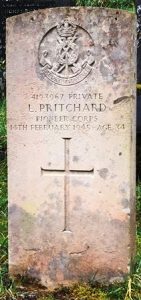
Charles Roughsedge, Gunner, 1705213, Royal Artillery. Charles was born in Kettering on 6 January 1916, the son of Charles Roughsedge and Sarah Jane Roughsedge (nee Jones). His father was killed at Ypres on 26 July 1917, and his mother moved back to her native Aberdyfi with young Charles. By 1939, Charles was living at Brynawel, Aberangell, where he worked as a quarry labourer. He married Mary Elizabeth Barnett in 1940, after enlisting into the Royal Artillery. Charles was then posted to the Haverfordwest area with 77 Searchlight Regiment, Royal Artillery. He died at Haverfordwest on 10 January 1941, aged 25, and his body was brought back home for burial in Aberangell Cemetery.